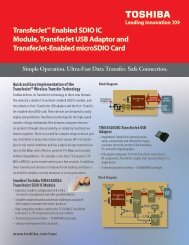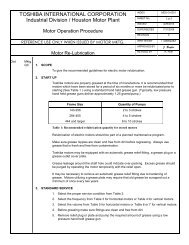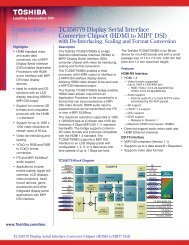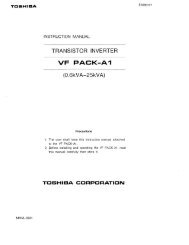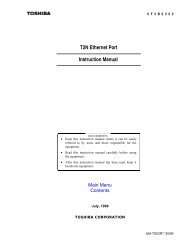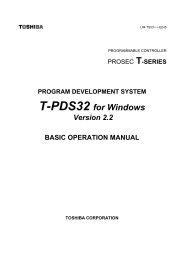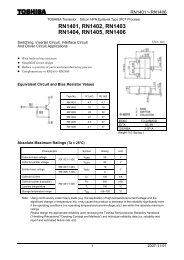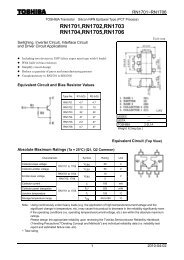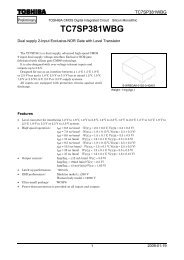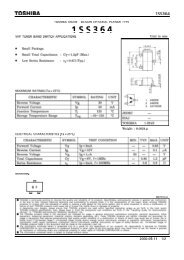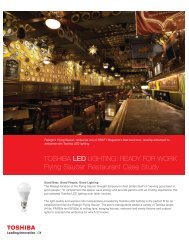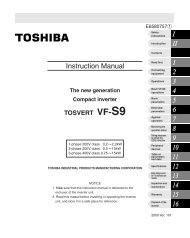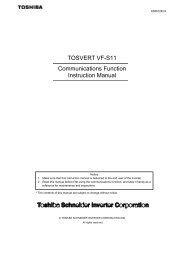VF-FS1 Industrial Inverter - Toshiba
VF-FS1 Industrial Inverter - Toshiba
VF-FS1 Industrial Inverter - Toshiba
You also want an ePaper? Increase the reach of your titles
YUMPU automatically turns print PDFs into web optimized ePapers that Google loves.
12<br />
Principal control functions<br />
L-2<br />
E6581381<br />
Common specification<br />
Item Specification<br />
Control system Sinusoidal PWM control<br />
Rated output voltage Adjustable within the range of 50 to 660V by correcting the supply voltage (not adjustable above the input<br />
voltage)<br />
Output frequency range 0.5 to 200.0Hz, default setting: 0.5 to 80Hz, maximum frequency: 30 to 200Hz<br />
Minimum setting steps 0.1Hz: analog input (when the max. frequency is 100Hz), 0.01Hz: Operation panel setting and<br />
of frequency<br />
communication setting.<br />
Frequency accuracy Digital setting: within ±0.01% of the max. frequency (-10 to +60°C)<br />
Analog setting: within ±0.5% of the max. frequency (25°C ±10°C)<br />
Voltage/frequency V/F constant, variable torque, automatic torque boost, vector control, automatic energy-saving, PM motor<br />
characteristics<br />
control. Auto-tuning. Base frequency (25 - 200Hz) adjusting to 1 or 2, torque boost (0 - 30%) adjusting to<br />
1 or 2, adjusting frequency at start (0.5 - 10Hz)<br />
Frequency setting<br />
signal<br />
External frequency potentiometer (connectable to a potentiometer with a rated impedance of 1 - 10kΩ), 0<br />
- 10Vdc (input impedance: VIA/VIB=30kΩ, 4 - 20mAdc (Input impedance: 250Ω).<br />
Terminal board base The characteristic can be set arbitrarily by two-point setting. Possible to set individually for three<br />
frequency<br />
functions: analog input (VIA and VIB) and communication command.<br />
Frequency jump Three frequencies can be set. Setting of the jump frequency and the range.<br />
Upper- and lower-limit<br />
frequencies<br />
Upper-limit frequency: 0 to max. frequency, lower-limit frequency: 0 to upper-limit frequency<br />
PWM carrier frequency Adjustable within a range of 6.0 to 16.0Hz (default: 8 or 12kHz).<br />
PID control Setting of proportional gain, integral gain, differential gain and control wait time. Checking whether the<br />
amount of processing amount and the amount of feedback agree.<br />
Acceleration/decelerati Selectable from among acceleration/deceleration times 1 and 2 (0.0 to 3200 sec.). Automatic<br />
on time<br />
acceleration/deceleration function. S-pattern acceleration/deceleration 1 and 2 and S-pattern adjustable.<br />
Control of forced rapid deceleration and dynamic rapid deceleration<br />
DC braking Braking start-up frequency: 0 to maximum frequency, braking rate: 0 to 100%, braking time: 0 to 20<br />
seconds, emergency DC braking<br />
Input terminal function Possible to select from among 58 functions, such as forward/reverse run signal input, operation base<br />
(programmable) signal input and reset signal input, to assign to 4 input terminals. Logic selectable between sink and<br />
source.<br />
Output terminal Possible to select from among 64 functions, such as upper/lower limit frequency signal output, low speed<br />
functions<br />
detection signal output, specified speed reach signal output and failure signal output, to assign to FL<br />
(programmable) relay output, RY output terminals.<br />
Forward/reverse run The RUN and STOP keys on the operation panel are used to start and stop operation, respectively. The<br />
switching between forward run and reverse run can be done from one of the three control units: operation<br />
panel, terminal board and external control unit.<br />
Preset speed operation Base frequency + 7-speed operation possible by changing the combination of 3 contacts on the terminal<br />
board.<br />
Retry operation Capable of restarting automatically after a check of the main circuit elements in case the protective<br />
function is activated. 10 times (Max.) (selectable with a parameter)<br />
Various prohibition Possible to write-protect parameters and to prohibit the change of panel frequency settings and the use<br />
settings<br />
of operation panel for operation, emergency stop or resetting.<br />
Auto-restart operation In the event of a momentary power failure, the inverter reads the rotational speed of the coasting motor<br />
and outputs a frequency appropriate to the rotational speed in order to restart the motor smoothly. This<br />
function can also be used when switching to commercial power.<br />
Drooping function The motor is allowed to “slip” according to the load torque current.<br />
Failure detection signal<br />
<br />
1c-contact output: (250Vac-0.5A-cosФ=0.4)<br />
Operation specifications



